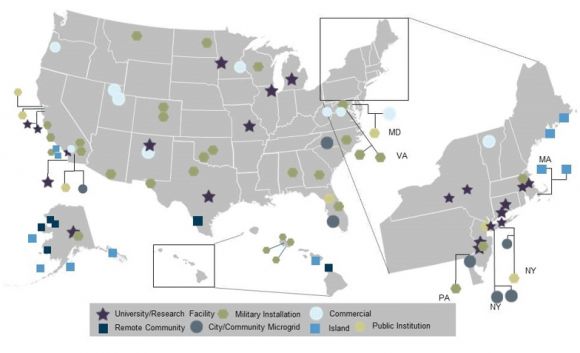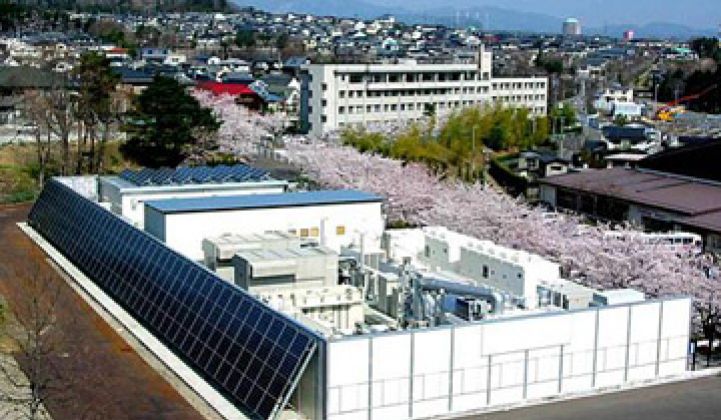Microgrids -- autonomous yet connected islands of energy generation and control -- could be important building blocks of a truly resilient, solar and wind-integrated power grid.
Someday.
But right now, the vast majority of the 1,051 megawatts of microgrids deployed in the U.S. are located at factories, college campuses, hospitals, military bases and other critical sites, and most use traditional combined heat and power and fossil-fuel-fired generation. These entities are not ready to hand over control of their critical microgrid asset for unclear grid benefits.
Most of the state microgrid programs launched in the U.S. so far -- Connecticut, Massachusetts, New York, New Jersey and Maryland among them -- have hewn to this reliability-first model, which emphasizes natural gas or diesel backup generators over solar, wind and other renewable resources. That makes sense, given that these states are mainly interested in preparing for another superstorm like 2011’s Hurricane Sandy, rather than field-testing innovative distributed energy-smart grid integration.
Leave that to California, which has just announced $26.5 million in grants for microgrid projects that put renewable integration front and center. Earlier this month, the California Energy Commission issued a program opportunity notice (PDF) seeking applicants that can “incorporate clean, low-carbon energy resources with energy storage and on-site energy management” to help meet the state’s carbon reduction and renewable energy goals.
CEC’s notice sets aside $6 million for projects that connect plug-in electric vehicles, with the remaining $20.5 million reserved for two groups. The first is “low-carbon-based microgrids for critical facilities” such as hospitals and fire stations. This category would appear to include more room for combined heat and power and natural-gas-fired backup generators, although the CEC demands that all projects must meet the Department of Energy's standards of having 20 percent lower emissions than a comparatively sized diesel generator.
The second group, “high-penetration renewable-based microgrids,” is defined as including projects that can incorporate “high amounts (up to 100%) of renewable energy to meet the facility/community load while avoiding adverse grid impacts, through the use of a microgrid controller/energy management system.” While microgrids of this kind are much rarer, they represent a large part of the coming market opportunity in microgrids, according to GTM Research’s report, Microgrids 2014: The Evolution of Localized Energy Optimization.

CEC’s proposal comes with some key requirements, including the ability to disconnect from the grid and self-power for at least three hours. All projects must also deliver on-site power “from renewable resources integrated with electric storage and demand response, to the extent feasible and cost effective.
California isn’t ignoring the grid resiliency side of the equation. It’s also looking for projects to help the state’s grid become more “resilient and adaptable to climate change impacts such as increased fires, severe storms, and heat waves."
California is already home to some cutting-edge microgrid projects; San Diego in particular is a hot spot. The University of California, San Diego is managing 42 megawatts of CHP, solar and backup on-site generation capacity with a campus-wide building energy management and load control platform, while San Diego Gas & Electric is integrating solar PV and community energy storage in its Borrego Springs microgrid project. Meanwhile, the U.S. Navy is working on technology to balance microgrids at three of its San Diego-based facilities, creating a self-balancing energy entity.

CEC’s funding remains fairly small, in keeping with the limited amounts that have been handed out in other state-funded microgrid programs to date. The CEC’s grants only require partners to provide 25 percent of the grant amount as matching funds, compared to the more common 50 percent match requirement, which means less private investment is at stake.
Finally, “microgrid technologies must be capable of being made commercially available at the end of the project (i.e., sold, leased, or licensed to the general public), in keeping with the intent of this solicitation to advance technologies towards large-scale deployment,” the CEC states. Applications for the grant program are due in November, with selected projects slated to begin work in 2015, so we’ll have to wait and see whether the technologies and approaches work as promised -- and whether they’re commercially viable on a broader scale.



